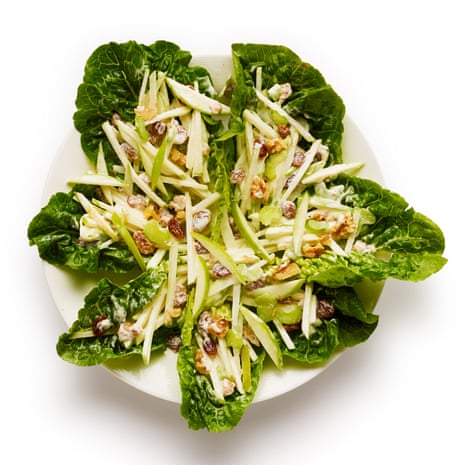Named after the Park Avenue hotel where it first saw the light of day, rather than, as Basil Fawlty would have it, “a walnut that’s gone orf”, the Waldorf salad has always carried with it a whiff of glamour that’s quite at odds with the actual dish. This simple chopped salad made its debut at a charity ball held at the New York hotel in aid of St Mary’s Hospital for Children in 1893, so it was designed for mass catering, rather than haute cuisine. It’s quick to put together, it can be made ahead of time without fear of wilting, and it also happens to use a couple of very seasonal ingredients. Perfect autumnal stuff.
The fruit and veg
It’s not often that recipes have a reliable origin story, but in this case, there seems little reason to doubt that the Waldorf is the creation of Oscar Tschirky, the Swiss maitre d’ who included the original in The Cook Book by “Oscar” of the Waldorf, published in 1896. Interestingly, his version contains only three ingredients: celery, apples and mayonnaise.
Celery, though not my favourite vegetable, is a non-negotiable part of a Waldorf salad, adding a fresh crunch and a subtle minerality, so if you’re more of a fan, feel free to go larger. However much you use, though, always peel the sticks, as Jamie Oliver explains, to get rid of “the stringy bits”. Tschirky and other early recipes such as that from Countess Morphy’s 1935 Recipes of All Nations dice the celery and the apple, often keeping the texture quite chunky (perhaps because Tschirky’s might have been designed to be eaten with one hand during breaks from dancing), but I prefer it thinly sliced, as in most modern versions.
Apples are the other must-have, though I do try one recipe, from The Robert Carrier Cookbook, that uses pears. They work very well, too, but since pears lack the acidity of most apples, I’d recommend using a sharper dressing with them than mayonnaise, which then begs the question of whether it’s still a Waldorf salad … but I’m getting ahead of myself.
To return to the classic choice, recipes are divided between red and green apples, with some, such as Oliver, favouring the sweetness of the former, and others, such as Simon Hopkinson and Kirsten Gilmour specifying granny smiths, the latter cautioning readers of her Mountain Cafe Cookbook to “make sure your apples are nice and crisp or they can really ruin the salad”. I’m with her on that – an element of sweetness is welcome in this salad, but the apples are here mainly to provide crunch and acidity. Red skins may look pretty, but they don’t deliver in the flavour department.
Hopkinson is the only one to peel the apples, but I like the odd flash of colour the skins supply much more than I enjoy peeling them off. I am going to copy him in cutting them into matchsticks, though, which feel and look more elegant than chunks, as well as increasing the dressing coverage. Sprinkle the cut apple with lemon juice to prevent it browning unattractively under its coat of mayonnaise.
With pears and red apples out, that leaves it up to something else to provide the sweetness. Grapes are popular, as used by Gilmour, Oliver and Joy of Cooking, but the more intense sugariness of Hopkinson’s sultanas, soaked in boiling water until plump and juicy, make for a more interesting juxtaposition with the creamy dressing. Note that Joy of Cooking also suggests substituting mini marshmallows for the grapes to make the salad more enticing to children, while Morphy adds bananas instead. But having tried both of these things enrobed in mayonnaise, I would not recommend either course of action.
The nuts

Tschirky’s original recipe doesn’t mention nuts at all. Walnuts first make an appearance in the 1928 The Rector Cookbook, and have been fairly standard ever since, though Hopkinson, who doesn’t care for them, substitutes blanched almonds, and I try hazelnuts in Morphy’s recipe, because she doesn’t specify a variety. As they’re included as much for texture as taste, I conclude that most nuts would work here, but the rich bitterness of walnuts remains my first choice – Rowley Leigh recommends the creamy fresh kind if you can get hold of them, but otherwise, toast them before using to bring out their nutty flavour.
The dressing
Not everyone uses mayonnaise – Oliver makes a mustardy, parsley-flecked, yoghurt-spiked vinaigrette to “freshen” his salad up, while Gilmour makes a garlicky, herby ranch sauce and Carrier gives reader sthe option of mayonnaise or “French dressing”. The last, flavoured with mustard powder, is certainly the better option with his sweet pears, but a classic Waldorf without a creamy, rich dressing doesn’t feel like a Waldorf to me.

Hopkinson is very clear that the mayonnaise must not be made with olive oil, and I agree that its strident flavour isn’t welcome here – I’d recommend making your own with sunflower oil or another neutral oil, but whatever type of mayonnaise you use, make sure it has some mustard in it, or stir a little in to taste; its subtle heat works brilliantly with the apple and walnuts in particular.
It’s common to thin the mayonnaise with something more acidic, such as soured cream (Lulu Grimes’ The Cook’s Book of Everything), creme fraiche or yoghurt (Leigh) or plain creamy, such as the double cream in Katie Stewart’s Cookbook. I appreciate the lightness that thick natural yoghurt brings, though creme fraiche also works well.
The extras

Oliver tops his salad with blue cheese, which, though delicious, has no place in a Waldorf, but the dash of extra-virgin olive oil he uses to finish the dish inspires me to suggest a drizzle of walnut oil instead. It’s not essential, but it does tie everything together quite nicely.
Like Gilmour, Oliver also tosses in some “interesting” leaves to bulk out his salad, but texturally they take the focus away from the chopped elements, so I prefer Grimes’ and Carrier’s suggestion of lining the dish with leaves instead, to keep the two a little more separate. This approach also has the distinct benefit, as far as I’m concerned, of looking pleasingly retro, even if it does detract from what Hopkinson describes, with some relish, as the dish’s “bland beige hue”. Win-win.
Perfect Waldorf salad
Prep 15 min
Serves 4
50g shelled walnuts, roughly chopped
50g raisins or sultanas, or 1 handful grapes (optional)
2 sharp green apples (eg, granny smiths)
1 lemon
2-3 celery sticks, or fewer, depending on taste
2 tbsp natural yoghurt, or creme fraiche (optional)
100g mayonnaise, preferably not made with olive oil
1 tsp dijon mustard, or to taste (optional)
Salt and black pepper
1 little gem lettuce, to serve (optional)
Walnut oil, to serve (optional)
Toast the walnuts in a dry frying pan until fragrant, then set aside to cool. Put the raisins in a small bowl and add enough boiling water just to cover; or cut the grapes in half, if using, and set aside.
Core the apples, then cut into matchsticks, put in a bowl and squeeze the lemon over the top. Peel and destring the celery, then thinly slice, add to the apple bowl and toss well.
Whisk the yoghurt or creme fraiche, if using, into the mayonnaise, then stir in the mustard and season to taste. Drain the raisins and add to the apple and celery (or add the grapes), and add the walnuts to the bowl, too. Pour the dressing over the top and toss to coat.
Separate the little gem into individual leaves and use these to line a salad dish. Scoop the salad mix into the middle, finish with a drizzle of walnut oil if, using, and serve.

Comments (…)
Sign in or create your Guardian account to join the discussion